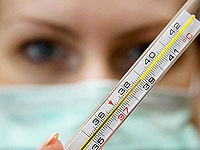Normal body temperature is one of the most important indicators of human health. What should be the temperature? From which it depends? Do I need to worry if it falls? What to do when it is raised?
Content
- What temperature is considered normal?
- Hypothermia and its causes
- Hyperthermia and its reasons
- Will a high temperature?
People belong to warm-blooded organisms, so throughout life «Forced» maintain its temperature in a framework defined by nature, and regardless of environmental features. Only under this condition the processes of life will occur at the proper level.
What temperature is considered normal?
 The body temperature is measured by the thermometer under the arm, in the mouth, in the rectum or exterior auditory passage. Since the temperature inside the body is somewhat higher than outside, measurement indicators differ by 1–5 degrees.
The body temperature is measured by the thermometer under the arm, in the mouth, in the rectum or exterior auditory passage. Since the temperature inside the body is somewhat higher than outside, measurement indicators differ by 1–5 degrees.
When measured in the axillary region, the temperature is considered in the range of 35.five–37,4 0WITH.
At a temperature level below 35.2 0C speak of hypothermia, if the temperature is above 37.3 0WITH — Oh Hypertermia.
If you take a temperature in the axillary region as an average of 36.6 0C, then he will correspond to the temperature in the rear pass 37.5 0S, mouth — 37.0 0WITH.
From what depends the body temperature?
Temperature of human body — The value is non-permanent, it varies depending on the time of day, the temperature conditions of the environment, the state of health and the existing diseases.
The lowest body temperature is marked in the morning hours, approximately 6:00, then it rises by 0.5–one 0C and in the evening reaches a maximum. Interestingly, these fluctuations are not determined by the level of human physical activity, but by biological rhythms, laid out by nature in accordance with the daily solar cycles.
When overheating, the temperature of the human body increases by one and a half degrees, when heocoled — decreases and may fall below 32.2 0WITH. In most cases, when the body is cooling to 29.5 0With a person loses consciousness, and at 26.5 0Most often dies. With increasing body temperature up to 44 0With blood proteins are coagulated, and man dies from hyperthermia.
In young children, due to the functional immaturity of the thermoregulation system, the body temperature can fluctuate in broader limits than in adults. In girls, the temperature level stabilizes to 13–14 years old, boys — By 18 years. In adult women, the body temperature is about half grades higher than that of men, it decreases in the middle of the menstrual cycle, during the ovulation and maximum level of estradiol, then rises by the time of the next menstruation or in the case of pregnancy.
The center of thermoregulation is in the brain, in the hypothalamus. The body's temperature is influenced by the level of the functional activity of the thyroid gland. Thyroid disease and brain tumors — The main causes of long and stable thermoregulation disorders. Hypothermia and hyperthermia lead to violation of life processes and can cause human death.
Hypothermia and its causes
Hypothermia, or a drop in human body temperature below 35.2 0C, is an indication for accessing a doctor, as well as high temperature. The condition is accompanied by angry, trembling in body, weakness, drowsiness, reduction of heart rate, disruption of coordination of movements.
The most frequent causes of hypothermia:
- supercooling,
- Chronic fatigue and insomnia,
- depression,
- Violation of the liver and gallbladder, including viral hepatitis with,
- Disorders of protein exchange, porphyria, anemia,
- Sugar diabetes and hypoglycemia,
- Reducing the function of the thyroid gland (hypothyroidism) and the drop in the level of its hormones affecting the metabolism and activity of the thermoregulation center,
- Temperature syndrome Wilsa,
- immunodeficiency, regardless of the causes of its development,
- Pneumonia and sepsis,
- parasitic infections,
- Heavy hanging syndrome,
- Diseases of the kidneys and adrenal glands,
- radiation sickness,
- Brain tumors,
- Carbon monoxide poisoning, mercury or other heavy metals.
Hyperthermia and its reasons
 Hyperthermia, or elevated body temperature, can be caused by increasing heat production and impaired its returns to the environment. Most often, the state is accompanied by the maximum voltage of thermoregulation mechanisms: expansion of surface skin vessels, increased sweating, rapid breathing and heartbeat. In severe cases, the body temperature reaches 41–42 0C, which leads to a thermal impact, violation of cardiac activity and turbidity of consciousness.
Hyperthermia, or elevated body temperature, can be caused by increasing heat production and impaired its returns to the environment. Most often, the state is accompanied by the maximum voltage of thermoregulation mechanisms: expansion of surface skin vessels, increased sweating, rapid breathing and heartbeat. In severe cases, the body temperature reaches 41–42 0C, which leads to a thermal impact, violation of cardiac activity and turbidity of consciousness.
Increased body temperature is observed in the following cases:
- With severe muscular work and during physical training,
- With nervous tension,
- While visiting the sauna, baths, when taking a hot bath, with a long stay in the sun or in a hot room,
- When drinking hot and sharp food,
- In case of violation of the vegetative nervous system (VD),
- in some chronic diseases,
- in diseases of blood and lymphatic system,
- With most dental diseases,
- With hidden bleeding,
- With poisoning,
- With hyperthyroidism.
Temperature of the body above 37.0 0C testifies to an acute inflammatory process in the body or gross violation of the work of the Center for Temoregulation.
Will a high temperature?
 Heat — reason to appeal for medical care. If the body temperature does not exceed 38 0C, hyperthermia does not represent danger. It is not worth shooting down this temperature, because in most cases it is a protective reaction and helps the body to fight infection and inflammation, except, of course, those cases when hyperthermia is caused by other reasons.
Heat — reason to appeal for medical care. If the body temperature does not exceed 38 0C, hyperthermia does not represent danger. It is not worth shooting down this temperature, because in most cases it is a protective reaction and helps the body to fight infection and inflammation, except, of course, those cases when hyperthermia is caused by other reasons.
If the body temperature is above 38 0C, before the arrival of the doctor, it is necessary to take the antipyretic drug. Subsequent examination will allow shed light for the causes of hyperthermia and find the correct way to solve the problem.
At temperatures above 40 0With the threat of life arises, in this case the antipyretic drug should be taken and immediately cause an emergency.
The most difficult hyperthermia is transferred to adults with diseases of the cardiovascular system, elderly people and babies. Older children with an increase in body temperature externally can look almost healthy, but this is not a reason to think that hyperthermia does not represent danger to them.
Hypertermia in patients with risk groups often acquires threatening forms, accompanied by convulsions, the development of heart failure, is difficult to control and treatment, which is why it is not worth pulling with the reception of the antipyretic drug and call a doctor.









